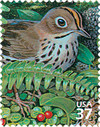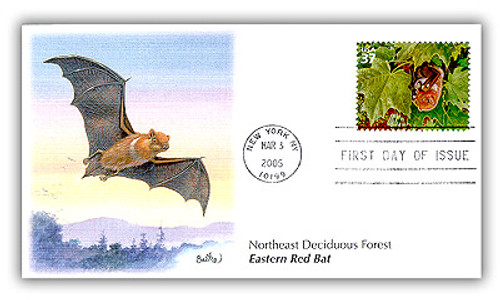
2005 37c Northeast Deciduous Forest: Ovenbird
# 3899h - 2005 37c Northeast Deciduous Forest: Ovenbird
$1.75 - $3.20
U.S. #3899h
37¢ Ovenbird
Northeast Deciduous Forest
Nature of America Series
37¢ Ovenbird
Northeast Deciduous Forest
Nature of America Series
Issue Date: March 3, 2005
City: New York, NY
Printing Method: Photogravure
Color: Multicolored
City: New York, NY
Printing Method: Photogravure
Color: Multicolored
Deciduous trees grow in a climate with cold winters, warm summers, and year-round precipitation. The broad-leaved trees of the Northeast deciduous forest shed their leaves annually in the autumn and early winter. When the dying leaves lose their green color in the fall, reds and golds emerge that create a spectacular display. A new set of leaves grows each spring.
Beech, maple, and birch trees predominate, with oak, black cherry, ash, elm, and aspen also present. The tallest of these trees form a dense, leafy canopy about 100 feet high. Little sunlight reaches the forest floor in the summer, where shade-tolerant mosses, ferns, and mushrooms grow. Shrubs, therefore, grow mainly in clearings and at the forest edges. Flowering plants flourish in the spring before the trees are fully leafed.
Snails, insects, and spiders are found in the forest as well as many cold-blooded animals such as snakes, frogs, salamanders, and turtles. Prominent mammals include birds, mice, moles, muskrats, chipmunks, squirrels, rabbits, weasels, beavers, foxes, bears, and deer. Many of the birds migrate south in the fall; some of the mammals hibernate during the winter.
The Northeast Deciduous Forest is the seventh issue of the Nature of America Series.
U.S. #3899h
37¢ Ovenbird
Northeast Deciduous Forest
Nature of America Series
37¢ Ovenbird
Northeast Deciduous Forest
Nature of America Series
Issue Date: March 3, 2005
City: New York, NY
Printing Method: Photogravure
Color: Multicolored
City: New York, NY
Printing Method: Photogravure
Color: Multicolored
Deciduous trees grow in a climate with cold winters, warm summers, and year-round precipitation. The broad-leaved trees of the Northeast deciduous forest shed their leaves annually in the autumn and early winter. When the dying leaves lose their green color in the fall, reds and golds emerge that create a spectacular display. A new set of leaves grows each spring.
Beech, maple, and birch trees predominate, with oak, black cherry, ash, elm, and aspen also present. The tallest of these trees form a dense, leafy canopy about 100 feet high. Little sunlight reaches the forest floor in the summer, where shade-tolerant mosses, ferns, and mushrooms grow. Shrubs, therefore, grow mainly in clearings and at the forest edges. Flowering plants flourish in the spring before the trees are fully leafed.
Snails, insects, and spiders are found in the forest as well as many cold-blooded animals such as snakes, frogs, salamanders, and turtles. Prominent mammals include birds, mice, moles, muskrats, chipmunks, squirrels, rabbits, weasels, beavers, foxes, bears, and deer. Many of the birds migrate south in the fall; some of the mammals hibernate during the winter.
The Northeast Deciduous Forest is the seventh issue of the Nature of America Series.









